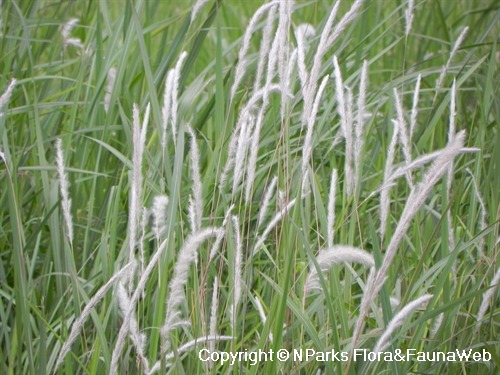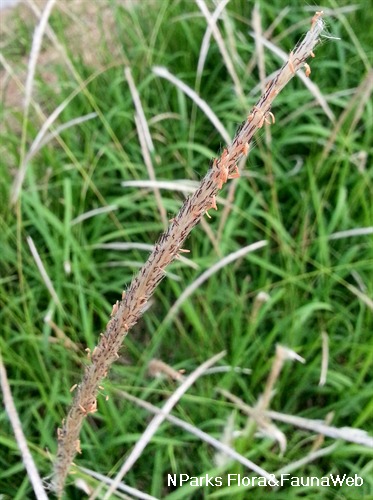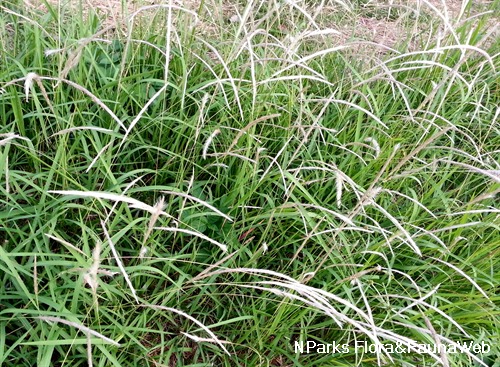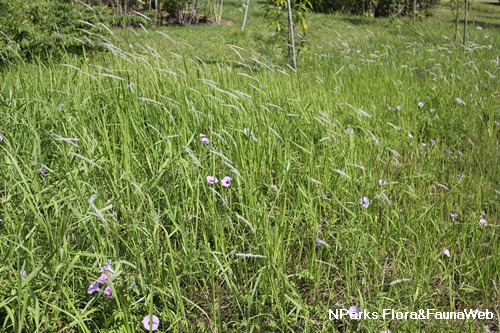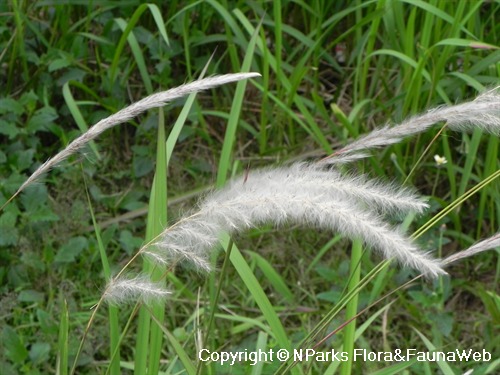
Back
Imperata cylindrica (L.) Raeusch.
| Family Name: | Poaceae (Gramineae) |
| Synonyms: | Imperata allang Jungh., Imperata arundinacea Cirillo, Imperata koenigii (Retz.) P.Beauv., Saccharum koenigii Retz. |
| Common Name: | Lalang, Cogon Grass, Alang-alang, Blady Grass, Speargrass, 白茅 |
Name
Classifications and Characteristics
| Plant Division | Angiosperms (Flowering Seed Plants) (Monocotyledon) |
|---|---|
| Plant Growth Form | Grass or Grass-like Plant (Tall Grass (Poaceae)) |
| Lifespan (in Singapore) | Perennial |
| Mode of Nutrition | Autotrophic |
| Plant Shape | Grassy |
| Maximum Height | 0.2 m to 2 m |
Biogeography
| Native Distribution | Southeast Asia, Australia, China, Japan, Philippines, and East Africa |
|---|---|
| Native Habitat | Terrestrial (Agricultural Land, Disturbed Area / Open Ground, Grassland / Savannah/ Scrubland) |
| Preferred Climate Zone | Tropical, Sub-Tropical / Monsoonal |
| Local Conservation Status | Native to Singapore (Least Concern (LC)) |
Description and Ethnobotany
| Growth Form | It is a tall perennial grass that grows 0.2 - 2.0 m in height. |
|---|---|
| Foliage | Linear leaves are held erect (180 cm long, 2.5 cm wide) and emerge from the stem bases. |
| Stems | The underground stem, known as a rhizome, is whitish and produces many stems. |
| Flowers | The plume-like inflorescence, known as a branched panicle, is white and hairy (30 cm long, 2 cm wide). Tiny, reduced flowers called florets are arranged in pairs, forming a spikelet. Each spikelet is composed of a sterile floret and a bisexual floret with 2 orange stamens (male parts) and 1 purple stigma (female part). The spikelets are typically arranged in pairs with one about twice as long as the other (0.8 mm long and 1.8 mm long). |
| Habitat | It can be found in sunny to moderately shaded fields, road sides, cultivated fields, and gardens. |
| Cultivation | This species is a significant weed of cultivated lands. The large, underground stem known as a rhizome is difficult to uproot. |
| Etymology | The genus Imperata is named in honour of Ferrante Imperato, an Italian pharmacist from the 16th century that is known for his work on natural history. The specific epithet cylindricus refers to the shape of the inflorescence. |
| Ethnobotanical Uses | Medicinal: In Chinese medicine, the underground stem is used to treat cough, coughing of blood, influenza, blood in the urine, internal bleeding, jaundice and kidney disease. The roots are used as a diuretic, to contain fever, to stop bleeding and to treat acute inflammation of the kidney and cough with phlegm. The flowers are prescribed when there is blood in the sputum, for nose bleeding and lung disease and to quench thirst. The underground stem is used in Indochina to treat itch in children and for piles. In Malaysia, it is used as a purgative as well as to treat diarrhoea and rheumatism. In Indonesia, the plant is used in cases of painful urination and blood in the urine. In the Philippines, it is prescribed for dysentery. |
Landscaping Features
| Landscape Uses | Parks & Gardens, Slope Stabilization |
|---|---|
| Usage Hazard - Cons | Invasive / Potentially Invasive |
| Usage Hazard - Cons Remarks | Invasive/Potentially Invasive: This species is a significant weed of cultivated lands. The underground stem is difficult to uproot and remove from the ground when established. |
Plant Care and Propagation
| Light Preference | Full Sun |
|---|---|
| Water Preference | Moderate Water |
| Rootzone Tolerance | Drought Tolerant, Moist Soils, Poor Infertile Soils, Heavy Clay Soils, Easy to Grow |
| Propagation Method | Seed, Storage Organ (Rhizome) |
Foliar
| Mature Foliage Colour(s) | Green |
|---|
Floral (Angiosperm)
| Flower Colour(s) | White |
|---|---|
| Flower Grouping | Cluster / Inflorescence |
Image Repository
Others
| Master ID | 30016 |
|---|---|
| Species ID | 4325 |
| Flora Disclaimer | The information in this website has been compiled from reliable sources, such as reference works on medicinal plants. It is not a substitute for medical advice or treatment and NParks does not purport to provide any medical advice. Readers should always consult his/her physician before using or consuming a plant for medicinal purposes. |

